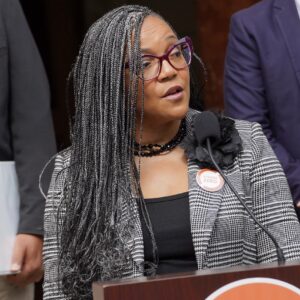
Oregon Bicycle Summit.
Andy Clarke, the Executive Director of the Washington D.C.-based League of American Bicyclists opened the second annual Oregon Bicycle Summit last night.
He addressed a packed audience of 125 advocates from around the state at the Fine Pine Lodge and Conference Center in Sisters. In his speech he said addressing an Oregon crowd was “daunting” because, “Oregon quite simply, rocks!” He said Oregon is
“setting the standard and leading the country in innovative policies and programs for bicycling.”
Clarke gave a recap of the National Bike Summit recently held in Washington D.C. and painted a picture that the bicycle movement has serious momentum on the national level. He implored us to take the opportunity to attach our values and ideas to the huge trend toward “being green” and showed a stack of mainstream fashion, business, and entertainment magazines trumpeting climate change and the environment on their cover.
After addressing the challenges and opportunities he relayed his feelings that bicycling might have reached a dangerous political crossroads.
“My sense is that we may have reached a federal funding ceiling. We have done well and seen the movement grow, but it will be tough to get to the next level.”
He cited charts that showed how, while federal funding for bicycle infrastructure and programs has increased dramatically since the 1970s, it has leveled off in recent years.

As an example, he pointed out a recent decision by Congress to rescind state’s transportation budgets. Facing a choice of which pots of money to pull from, many states (Oregon was one of the worst offenders) chose to send back money that had not yet been used to fund bicycle and pedestrian projects (from a program known as Transportation Enhancements).* [*This is big and complex issue I hope to write about more soon. Learn more here.]
Clarke kept asking “Why?”. Why are bicycle facilities given such a paltry share (1%) of the U.S. transportation budget pie? Why do we still have to fight against outdated (and frankly discriminatory) laws that discourage cycling? Why is the U.S. traffic fatality rate five times higher than European cities?
Clarke said the key to the bicycle movement going to the next level is to change our tone. He said we should be, “less passionate and more practical,” in communicating the benefits and joys of bicycling to others.



Thanks for reading.
BikePortland has served this community with independent community journalism since 2005. We rely on subscriptions from readers like you to survive. Your financial support is vital in keeping this valuable resource alive and well.
Please subscribe today to strengthen and expand our work.
A suit and tie? Give me a break.
Aw, he’s British. Give him a break.
Nice macaroni… what do you care what the guy is wearing? He is FOR cycling. Unfortunately if cyclists would like to see their cause advanced, we need some “suit and tie” people doing the talking. If you show up asking for government funded bikeways and paths wearing dickies cut off at the knees, black tennis shoes, and a bike jersey, you’re going to walk away empty handed.
Reality whether you like it or not.
You know (random personal observation here), I was just driving through Centralia, WA today and something struck me…
there was an older guy riding a bicycle on the bike lane in the city. In a small WA town, no less.
Which brought back memories of my childhood, 10-15 years ago… and I can’t EVER recall seeing people riding bikes in small towns (neither did I live in Portland).
Anyways, thought it was a great sign of progress that even smaller cities throughout the US are seeing people ride bicycles, where you wouldn’t have seen it even 8-10 years ago.
I love the variety of people who are into bikes. Kids on bikes, moms on bikes, business people on bikes, zoobombers, clowns, ladies in dresses, bunnies.
To me, the more people who ride bikes and the variety of reasons for which they ride simply makes the world a better place.
When we ride we symbolize action. We ride because we want exercise. We ride because we don’t have or don’t want to have a car. We ride because we like to smell the changing seasons. We ride because we want to see our neighbors. We ride because we like to have fun. We ride because it just makes sense.
Huh Zilfondel?
I grew up in Grants Pass in the eighties – a decidedly small town, and my own early memories of cycling are that there were MORE people on the roads then than now. And people of all stripes, too – kids, older folks, commuters and families.
A simple, appalling stat on the changes in the # of kids walking & biking to school corroborates my experience – 30 years ago 60% of kids walked or biked to school; today 10% do.
I got my own first fix of cycling as a way to move long distances through the Boy Scouts cycling merit badge. Our leaders were old guys in blue jeans who taught us the joy of getting someplace under your own power in between reciting the pledge of allegiance and the Boy Scout Oath.
Old guy riding in Centralia? – a good sign indeed. “Old” guys and gals who come back around to cycling as a way to improve health, save money, limit the effects of global warming (now a mainstream issue), spend quality time wiht the grandkids, and generally enjoy their Baby-Boomer retirement represent the biggest opportunity for cycling to grow exponentially in the next 10-15 years.
One of the most exciting things about this is that all of the above are non-partisan issues.
Providing the educational resources and infrastructure for them to do it safely and comfortably represents the most important challenge for the cycling industry and public agencies and advocacy ppl, along with efforts to get kids back on bikes.